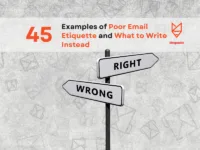Effective communication is a cornerstone of professional relationships, and knowing how to address your manager in an email is crucial. Whether you’re reaching out for a quick question, providing updates on projects, or formally requesting time off, the way you address your manager sets the tone for your message. In this blog post, we’ll explore the best practices for addressing your manager in emails, including tips, common titles, and examples to help you navigate this important aspect of workplace communication.
Why Proper Addressing Matters
Using the correct salutation when emailing your manager demonstrates respect and professionalism. It establishes a positive tone and shows that you understand workplace etiquette. Misaddressing your manager can lead to misunderstandings or create an impression of carelessness, which you want to avoid.
Common Ways to Address Your Manager in an Email
- Formal Titles:
- Mr./Ms./Mrs. [Last Name]: Use this format if you are in a formal workplace or if your relationship with your manager is more traditional.
- Dr. [Last Name]: If your manager holds a doctorate, this is the appropriate title to use.
- Professional Titles:
- [Job Title] [Last Name]: In some workplaces, addressing your manager by their job title (e.g., “Director Smith”) is preferred, especially in formal communications.
- First Name:
- Depending on your company culture, using your manager’s first name can be acceptable, especially in more casual environments. However, it’s best to wait for your manager to initiate this level of familiarity.
- Team or Department Names:
- In some cases, addressing your manager by their team or department name (e.g., “Marketing Team Lead”) can be appropriate, especially in group emails.
Tips for Addressing Your Manager in an Email
- Know Your Company Culture:
- Understand the norms of your workplace. Some companies favor a formal approach, while others embrace a casual atmosphere. Pay attention to how your colleagues address your manager.
- Follow Their Lead:
- If your manager signs off their emails with their first name or encourages a casual tone, feel free to mirror that in your communications.
- Use a Polite Greeting:
- Start with a polite greeting, such as “Dear,” “Hello,” or “Hi,” followed by the appropriate title or name. For example, “Dear Ms. Johnson” or “Hi John.”
- Be Consistent:
- Once you establish a way to address your manager, stick with it throughout your emails to maintain consistency and professionalism.
- Avoid Over-Familiarity:
- Unless you have a close relationship with your manager, avoid overly casual greetings like “Hey” or “What’s up.”
Examples of Addressing Your Manager in Emails
- Formal Email:
- Subject: Request for Meeting Dear Mr. Thompson, I hope this message finds you well. I would like to schedule a meeting to discuss our upcoming project timeline. Please let me know your available times. Thank you for your consideration. Best regards, [Your Name]
- Casual Email:
- Subject: Quick Question Hi Sarah, I hope you’re having a great day! I have a quick question regarding the marketing strategy we discussed last week. Could we chat for a few minutes? Thanks! Best, [Your Name]
- Team Email:
- Subject: Project Update
- Hello Team, I wanted to provide an update on our current project. If anyone has questions or needs clarification, please feel free to reach out. Best, [Your Name]
How to Ask Your Manager How They Like to Be Addressed
Understanding how to address your manager can enhance your professional relationship and foster a respectful work environment. If you’re unsure about the appropriate title or form of address, it’s perfectly acceptable to ask your manager directly. Here are ten ways to phrase your inquiry:
- “Hi [Manager’s Name], I want to make sure I address you correctly. Do you prefer Mr./Ms. [Last Name] or just your first name?”
- “Hello, [Manager’s Name]. I’d like to clarify how you prefer to be addressed in emails and meetings. Is it okay to call you [First Name]?”
- “Hi [Manager’s Name], I noticed some people address you differently. What’s your preferred way to be addressed?”
- “Dear [Manager’s Name], I want to ensure I’m being respectful. How would you like me to address you?”
- “Hello [Manager’s Name], I’m new to the team and want to make sure I’m addressing you appropriately. What do you prefer?”
- “Hi [Manager’s Name], I’d like to know how you prefer to be addressed. Should I use your title or your first name?”
- “Hi [Manager’s Name], I want to ensure I’m being professional. How would you like me to refer to you?”
- “Hello [Manager’s Name], I’m trying to get the hang of the team dynamics. Do you have a preference for how I address you?”
- “Dear [Manager’s Name], I want to be respectful in our communications. What’s your preferred form of address?”
- “Hi [Manager’s Name], I’m curious about how you like to be addressed in our correspondence. Is it okay to use your first name?”
Frequently Asked Questions (FAQs)
1. Why is it important to ask how to address my manager?
Understanding your manager’s preference shows respect and helps establish a positive working relationship. It also reflects your professionalism and willingness to adapt to workplace culture. Even if others in your workplace address your manager on a first-name basis, its better to check before following their lead.
2. What if my manager doesn’t respond to my inquiry?
If your manager doesn’t respond, you can observe how they introduce themselves or how others address them. If in doubt, it’s safer to use a formal title until you get more information.
3. Is it ever appropriate to use a nickname when addressing my manager?
Using a nickname is generally acceptable only if your manager has indicated that they prefer it. Always err on the side of caution and use their formal name until you receive clarification.
4. How should I address my manager in a group email?
In a group email, it’s best to use a formal greeting, such as “Dear [Manager’s Title] [Last Name],” to maintain professionalism, especially if others are included in the conversation.
5. Can I use their first name if they are younger than me?
Age should not dictate how you address your manager. Always follow their lead; if they introduce themselves using their first name, it’s typically acceptable to use it in your communications.
6. What if my company has a casual culture?
In a casual work environment, it may be acceptable to use first names. However, it’s still a good idea to confirm your manager’s preference to ensure you’re aligned with their expectations.
7. Should I change how I address my manager if I move to a different department?
If you transition to a different department, it’s wise to reassess how to address your new manager. Company culture and individual preferences may vary, so it’s best to ask again.
Understanding Workplace Culture is Key
Addressing your manager correctly in an email is essential for maintaining professionalism and fostering effective communication. By understanding your workplace culture, knowing the appropriate titles, and following the tips outlined in this guide, you can ensure that your emails are respectful and well-received.
By approaching the topic with respect and consideration, you can foster a positive communication dynamic with your manager, ensuring that both of you are comfortable in your interactions.




